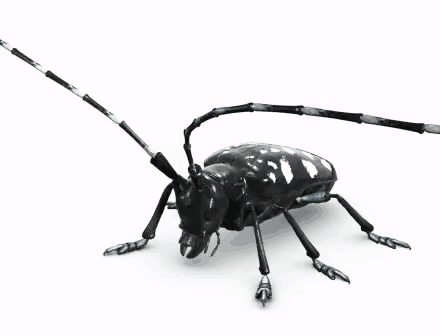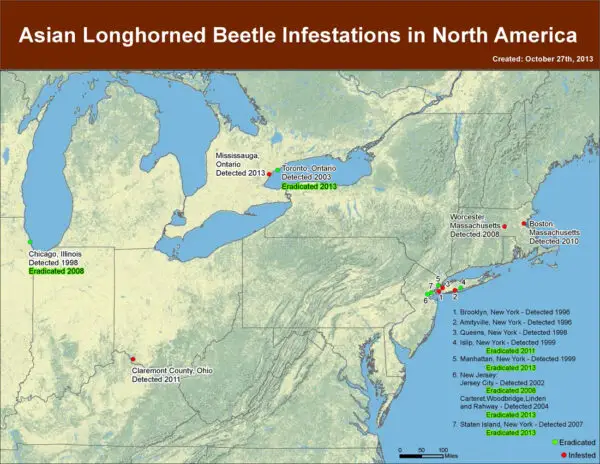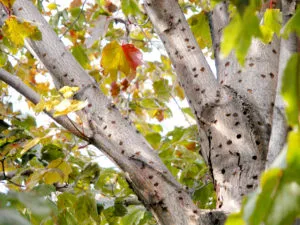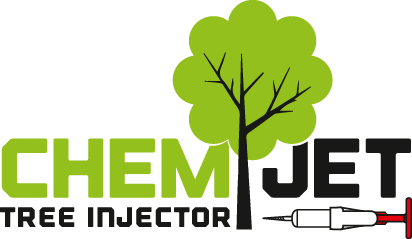Asian Longhorned Beetle Treatment

Asian Longhorned Beetle Treatment
Asian Longhorned Beetle Treatment with trunk injection of pesticides can save your trees from this nasty new invasive species.
The Asian Longhorned Beetle feeds on a wide variety of trees in the United States, including maples, eventually killing them. The beetle is native to China and Korea and was first discovered in New York City in 1996. Adult beetles are large, distinctive-looking insects measuring 1 to 1.5 inches in length with long antennae. Their bodies are black with small white or yellow spots, and their antennae are banded.
Other Treatments and Info
- Oak Wilt Prevention and Treatment
- Save Your Trees from Oak Wilt
- Microinjection to Protect Trees From Oak Wilt
- Emerald Ash Borer Treatment
- Dutch Elm Disease
- Pine Bark Beetle Injection Treatment
- Sudden Oak Death
- Hemlock Woolly Adelgid Treatment
- Asian Longhorned Beetle Treatment
- Caterpillars, Beetles, Borers
- Orchard Crops Treatment
- Plugs for Tree Injection Holes
- Chemjet Tips and Ideas

ALB Distribution
The USDA and state agencies have been very aggressive in working to eradicate any discovered ALB infestations, because of the potential for devastation of North American forests. This 2013 map shows a distribution of locations where ALB has been identified. There are also reports of ALB in California and Florida.
The occurrence of ALB is limited, but tree owners should be vigilant and look for signs of infestation. Besides observing the distinctive beetles, there is evidence that can be found on a tree that may mean your tree is infested, and if you see a beetle or find this evidence of ALB, please be sure to report it to your state department of natural resources and the USDA by calling the hotline at 1-866-702-9938.
- Exit holes – In the warmer months the adult beetles chew their way out of the tree leaving, ¼ inch or larger, perfectly round exit holes.
- Egg sites – Adult female beetles chew up to 90 oval depressions, called oviposition sites or egg sites, into the bark of the host tree. She lays a single egg beneath the bark at each site. These look like little wounds on the tree, and you can sometimes see the chew marks on the edges.
- Frass – As the larvae tunnel and feed, it often pushes sawdust-like material or excrement, called frass out onto the ground around the tree or onto the tree branches.
- Tunneling – After the egg hatches, the larva tunnels into the growing layers (phloem and cambium) of the tree and eventually into the woody tree tissue (xylem). If you have a fallen branch or are cutting wood, you may see this tunneling.
- Weeping sap – Tree sap may be seen flowing from the wounds or egg sites..
- Unseasonable yellowing leaves – Seeing leaves turning colors sooner than they should could indicate the tree is under stress.
- Branches dropping or dying – If the tree has lost a branch or has a dead branch showing it could be a sign that something is wrong.
Do Not Transport Infested Wood
Cutting up trees infected by ALB for lumber, firewood or tree trimming and transporting the infected wood to new areas will transport the ALB to infest and kill trees in these areas. Do not transport any wood or brush from ALB killed trees. Adult beetles will still emerge in the spring and summer from fire wood which was cut the previous winter.

Asian Longhorned Beetle Treatment
For Asian Longhorned Beetle Treatment, the USDA has identified that trunk injection treatments can be used to protect unaffected trees in or near ALB areas. This can be easily conducted using Chemjet® Tree Injectors to inject pesticides such as imidacloprid (like Ima-Jet 5%). into small drilled holes at several locations around the circumference of the tree. The chemical is then carried throughout the tree, from up to the leaves down to all of the roots, effectively killing or driving away ALB currently in the tree, and preventing future infestation by visiting beetles.
Other Treatments and Info
- Oak Wilt Prevention and Treatment
- Save Your Trees from Oak Wilt
- Microinjection to Protect Trees From Oak Wilt
- Emerald Ash Borer Treatment
- Dutch Elm Disease
- Pine Bark Beetle Injection Treatment
- Sudden Oak Death
- Hemlock Woolly Adelgid Treatment
- Asian Longhorned Beetle Treatment
- Caterpillars, Beetles, Borers
- Orchard Crops Treatment
- Plugs for Tree Injection Holes
- Chemjet Tips and Ideas

